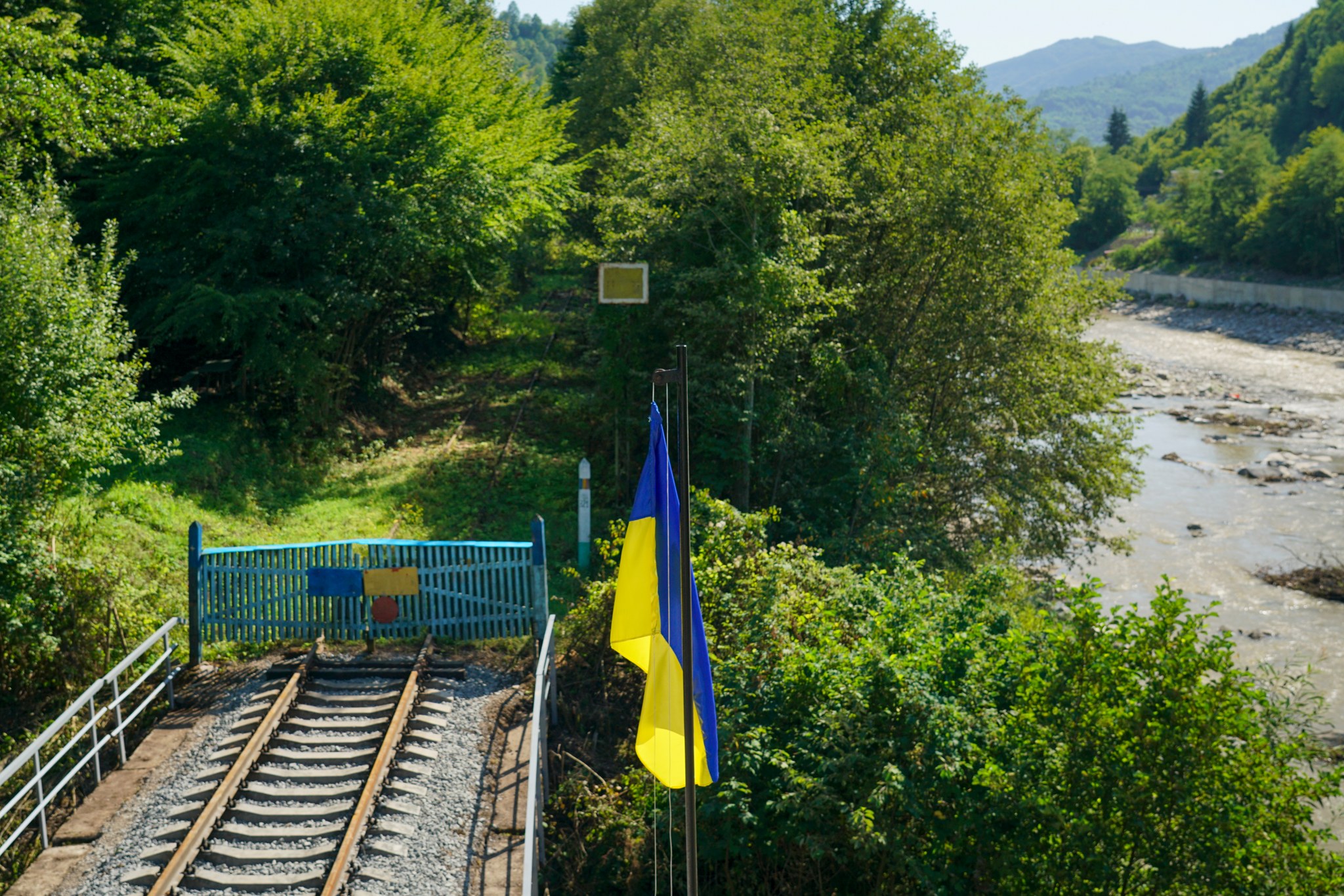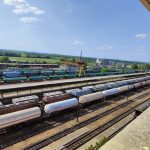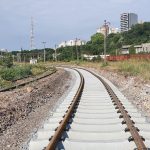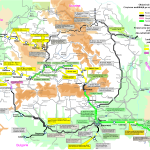 The war at the EU border and its aftermath have highlighted the Romania-Ukraine rail connections issues and further disruptions to the rest of Europe, creating chaos when Ukrainian goods were blocked. The authorities, together with many transport operators, have been working to help get goods out of Ukraine and to various destinations, creating special corridors as a result of quickly implemented initiatives. While transport services have been secured, the actions have emphasised the need for an adequate infrastructure that can cope with traffic, is connected and offers availability.
The war at the EU border and its aftermath have highlighted the Romania-Ukraine rail connections issues and further disruptions to the rest of Europe, creating chaos when Ukrainian goods were blocked. The authorities, together with many transport operators, have been working to help get goods out of Ukraine and to various destinations, creating special corridors as a result of quickly implemented initiatives. While transport services have been secured, the actions have emphasised the need for an adequate infrastructure that can cope with traffic, is connected and offers availability.
The war in Ukraine has led to major disruptions in Europe both economically and socially, with connectivity being a key component from the very beginning in February 2022 when Russia invaded Ukraine’s territories.
The movement of Ukrainian citizens, as well as the logistics of freight transport, has been a real effort not only for Ukraine, but also for neighbouring countries, which have committed themselves to supporting it, with transport corridors being essential. The major impact is currently being felt particularly in international trade, with Ukraine’s transport infrastructure being severely affected, in turn causing massive disruptions in the logistics chain and thus in the delivery of goods.
According to a World Bank document published in February 2023, damage in the transport sector is estimated at USD 35.7 billion, including road, rail and urban transport infrastructure, as well as rolling stock and other assets. The document states that as of June 2022, five regions of Ukraine are facing serious problems with railway infrastructure which in figures means damage to 88 railway stations and over 400 railway bridges. Losses to the Ukrainian transport sector are estimated at USD 31.6 billion by 2024, dominated by disruptions to Black Sea shipping. Apart from air transport, which clearly faces massive losses as the industry is shut down, elements facing losses include access to and from ports (64%), rail and road infrastructure, with 7% each. Based on the analysis, the paper published by the World Bank shows that rebuilding rail infrastructure, including stations, rolling stock, equipment and other assets will require investments of about USD 3.2 billion by 2026, of which the largest amount is needed for rail infrastructure – USD 2.8 billion. For the next decade, the same categories need more than USD 27 billion in investment, of which rail infrastructure requires more than USD 23 billion, rolling stock USD 2.4 billion and equipment USD 1.4 billion. Add to this USD 694 million for the reintroduction of services between 2023 and 2033.
In January, the Ukrainian government announced that it had already identified UAH 11 billion (about EUR 3 billion) worth of resources for infrastructure reconstruction and expects to accumulate up to six times more (i.e. EUR 18 billion) to rebuild infrastructure and housing, Prime Minister Denys Shmyhal said.
Many institutions have shown their interest and commitment to the recovery of the transport infrastructure, including the Romania-Ukraine rail connections, and money has already been allocated to projects to restore transport links to Western Europe. In addition, Ukraine has succeeded, through negotiations with the European Union, in gaining the right to absorb funds through the Connecting Europe Facility (CEF), for which an agreement was signed in June 2023 between the European Commissioner for Transport Adina Vălean and the Minister of Development of Communities, Territories and Infrastructure, Olexander Kubrakov. As a result, Ukraine is entitled to apply for projects for funding through the CEF Transport Calls for the period 2021 – 2027, with the eligibility criteria for third countries outlined in the TEN-T Regulation being applied, with priority being given to projects that result in the strengthening of transport links on the Core Network belonging to Member States and third countries.
“One of the sectors we are focusing on is the recovery of transport infrastructure and export logistics, especially through the ports in the Danube Region. In the last year and a half, the ports of Izmail, Reni and Ust-Dunaisk (the latter located in the Odessa Region) have seen a tripling of cargo volumes. Our aim is to increase capacity so that they can handle 30 million tonnes a year,” says Olexander Kubrakov.
In September 2023, Olexander Kubrakov announced that these projects become a priority for CEF funding and will be the key point in optimising transport connections with the European Union through the development of the TEN-T network.
All these actions are part of the European Commission’s Solidarity Lanes initiative, whose plan was launched in May 2022 to establish alternative logistical routes on rail, waterways and road infrastructure, in particular for the transport of cereals. It should be noted that the route involving the Black Sea was closed due to the war, preventing the export of 20 million tonnes of grain, including equipment. The Ukrainian Railway Company, Ukrzaliznytsia, announced that in June 2023 it recorded a 32% increase in the volume of cargo transported compared to the same month of the previous year, reaching 12.4 million tonnes. Compared to May 2023, in June the volume transported by the company increased by 8%.
Official data from the European Commission show that this initiative has contributed to the export (from Ukraine) of more than 42 million tonnes of non-agricultural products, represented by minerals, iron, steel and wood, generating revenues of EUR 38 billion for Ukrainian farmers and businesses. One of the biggest issues raised by Ukraine, the European Union and other countries is the transport of grain, which is the main focus of globally supported initiatives. Solidarity Lanes has helped transport 48 million tonnes of grain, oilseeds and related products (from Ukraine), enabling 60% of Ukrainian grain to be exported. The remaining 40% could be transported through the Black Sea Grain initiative, launched by Russia, Turkey, Ukraine and the United Nations in July 2022.
The latest EU statistics show that as of March 2022, 68.5 million tonnes of cereals are EU exports to third countries. Under normal conditions, Ukraine exports 75% of the total volume of cereals, generating about 20% of the annual national export revenue, with 90% of the transit through Ukrainian Black Sea ports to Europe, China and Africa. Over EUR 1 billion has also been mobilised through this initiative to increase global food security and support Ukraine’s economy.
Since July 2022, the European Commission has intensively addressed the issue of connectivity with Ukraine and thus Moldova, by launching the TEN-T extension proposal (to these non-EU countries), allocating (in December 2022) EUR 220 million to support military mobility and infrastructure optimisation projects on the Solidarity Lanes corridors in Germany, Poland and Romania, and providing EUR 250 million investment for nine Solidarity Lanes projects to improve cross-border connections between Ukraine, Moldova and the European Union.
The railways play a key role in delivering large volumes of goods and have the capacity to create viable links across the international space, ensuring the smooth flow of traffic and contributing to international trade consolidation and development. At a time when Ukraine needs to transport its goods to other countries, and is facing connection problems of its own due to the war that has led to the closure of transport links and the blocking of large volumes of freight, Romania has a vital role to play in cross-border connections and providing vital links to the rest of Europe.
Projects needed
At the beginning of 2023, the Romania-Ukraine rail connections were a milestone for the authorities, with the Rahov (Ukraine) – Viseul Valley (Romania) section being put into operation, crossed by a passenger train for the first time in 17 years. The event discussed plans to develop rail infrastructure and open new cross-border points, both rail and road, to facilitate transport flows.
In August 2023, Romanian Prime Minister Marcel Ciolacu and his Ukrainian counterpart Denys Shmyhal met in Bucharest to discuss measures and solutions to support Ukraine. One of these involves facilitating Ukrainian grain exports to international markets for which the focus is on “developing existing capacities and corridors – first and foremost the Sulina Canal and the Port of Constanta – in order to achieve our ambitious target of doubling the volume of Ukrainian grain transit through Romania”, said Marcel Ciolacu.
The two officials discussed ongoing transport infrastructure projects, including rail projects of cross-border importance and Romania’s efforts to expand logistics capacity to ensure and facilitate transit flows. In this regard, an agreement was signed on strengthening bilateral cooperation in ensuring reliable transit of goods from Ukraine. The agreement involves the revitalisation of the transport infrastructure destroyed due to the war, the opening of new cross-border rail, road, sea and sea crossings, as well as the development of access to rail and road infrastructure to these crossings and the implementation of traffic management mechanisms that will reduce congestion and simplify customs procedures. In addition, the two sides agreed to facilitate the transhipment of Ukrainian products to Romania by sea and inland waterways through existing ports. “We are grateful for Romania’s support by (…) taking a constructive stance on the issue of Ukrainian grain transit,” said Denys Shmyhal after signing the agreement.
To contribute to the development of connectivity, the European Commission and the European Investment Bank (EIB) published a study (Strategy for the EU integration of the Ukrainian and Moldovan rail Systems) outlining measures, solutions and projects facilitating cross-border links to ensure a good connection of Ukraine and Moldova with the EU rail network. The study shows that in this respect that the Romania-Ukraine rail connections are represented by six cross-border points on European gauge infrastructure (1435 mm), the change of gauge being the requirement for trains to cross border points:
- Satu Mare – Halmeu (Romania) – Diakove – Koroleve (Ukraine) – double gauge line used for rail freight services;
- Sighetu Marmației – Câmpulung la Tisa (Romania) – Teresva (Ukraine) – double gauge connection to the Vise Valley which was taken out of use because a road bridge was opened over the Tisa between Solotvino and Sighetu Marmației;
- Sighetu Marmatiei – Valea Vișeului (Romania) – Dilove – Rakhiv (Ukraine) – this route at the Valea Vișeului crossing has a gauge of only 1520mm and was taken out of use because it was heavily damaged by floods in 2006;
- Dornesti – Vicesani (Romania) – Vadu Siret – Chernivtsi (Ukraine) – route which is open to passenger and freight traffic and benefits from gauge changing facilities (in Vadu Siret);
- Barboși – Galați (Romania) – Reni (Ukraine) – double gauge route between the transhipment area in Galați and the Port of Giurgiulești in Moldova, with the 1520mm gauge line going to Reni;
- Constanta (Romania) – Illichivsk (Ukraine) – 1520mm gauge line with European gauge change facilities in Constanta.
It is worth mentioning that DP World has set up an intermodal terminal in Dornesti (in the north-east of Romania) to facilitate and increase the efficiency of traffic on the Ukraine – Constanta route, crossing the Vadu Siret cross-border point.
The terminal covers an area of 2.5 hectares and has a capacity for 1,250 large containers or 2,500 small containers and also offers services for customs operations. The commissioning of this terminal contributes to the reduction of congestion through the Port of Constanta caused by the large number of Ukrainian trucks and the increase of rail traffic, thus increasing the volumes absorbed by this mode of transport, which means that drivers no longer have to drive 700 km to the Port of Constanta, where they also lose a lot of time for customs procedures. DP World’s new rail service has the capacity to offer more than five round-trip trains a week, with each train capable of carrying around 50 containers. Travel time (between Dornești and the Port of Constanta) is 36 hours.
Also in the Port of Constanta there is the Valu lui Traian station which is to be modernised by the railway infrastructure manager CFR SA. In September, CFR SA announced that five bids for design and modernisation works were submitted in the tender procedure as part of the programme to modernise the railway infrastructure in the port, financed by non-reimbursable CEF funds.
The estimated value of the contract for the modernisation of the Valu lui Traian station is estimated between RON 402.3 million (EUR 81.3 million) and RON 457 million (EUR 92.3 million). The technical design work will take six months and the execution of the works 20 months. The project involves the construction of a station waiting group comprising 32 receiving and dispatching lines which will be electrified, the construction of electronic centralisation and a diagonal to maintain the level crossing, the integration of the new electrification installations into SCADA and telecommunications works.
The Port of Constanta benefits from a network of 257 km of which 180 km are lines managed by CFR SA and requires an investment of RON 4.5 billion (EUR 909 million). In the framework of the 2022 CEF call for proposals, the European Commission has selected the project for the modernisation of the railway infrastructure in the Port of Constanta (Phase II) with a recommended funding of EUR 106.7 million. The project aims to improve the port’s rail connections, including both infrastructure and railway stations, electrification and construction works and the introduction of electronic signalling and telecommunication systems. The project, which is an important part of the Solidarity Lanes initiative, will help increase connectivity between the port and rail transport and improve the efficiency of operations and traffic flows.
In addition to these projects which also contribute to increasing/improving access to rail services and integrating transport modes, Romania needs to modernise its rail infrastructure towards the border points with Ukraine which are provided by Corridor IX, branch 2b. Romania is crossed by two European corridors: the Rhine – Danube and the East/East Mediterranean.
Rehabilitation of the corridor which on the Romanian territory starts from the south-east (Giurgiu), through the capital (Bucharest), crossing north to Focșani, Bacău, Pașcani, Iași, towards Ungheni, in the Republic of Moldova.
Within the 2021 – 2027 Transport Programme, Romania has listed railway infrastructure modernization and rehabilitation projects, including the routes Pascani – Iasi – Ungheni and Ploiesti Triaj – Focsani – Roman – Pascani – Dărmănești – Dornești – Vicsani Border (with Ukraine), both of which have also been selected as priority projects for the period 2023 – 2026.
The achievement of an efficient connection with Ukraine involves the rehabilitation and modernization project of the Dărmănești – Dornești – Vicsani Frontier section of the line (on the TEN-T Core Network) over 35 km long. The project also includes electrification works to be carried out on 32 km of line. The value of the investment is estimated at RON 1.8 billion (EUR 370 million) and the works are expected to be completed within 36 months from the date of signature of the contract. Completion of the project will allow passenger trains to run at speeds of 160 km/h and freight trains at 100 km/h, up from an average of 50 km/h at present.
Pașcani – Iași (Romania) – Ungheni (Rep. of Moldova) is part of the connection to Chisinau which needs modernisation and electrification, as well as the transition to European gauge (from 1520mm). The study published by the European Commission in July 2023 considers the introduction of European gauge on this section. The Pascani – Iasi line is 76 km long and is a double line, electrified and with European gauge. From Iași to Ungheni Border, the line is also double, with European gauge up to Socola station (Romania) on a length of 5 km, and from Socola the length of 17 km is single and non-electrified. The modernisation of the 97 km long Pascani – Ungheni line is also included in Romania’s Transport Programme 2021-2027, and is a project estimated at EUR 388 million. It is in need of upgrading as it is at various stages of wear and tear and has exceeded its normal operating life. Due to speed restrictions, the average train journey time on the Pașcani – Iași route is between 63 and 85 minutes, and on the Iași – Ungheni route 42 minutes.
In 2022, Petru Movilă, city manager of Iasi, asked the Romanian Government to get involved in financing the project to modernize the Socola – Ungheni line, which has double gauge (1435mm and 1520mm) “the Ukraine – Moldova transport corridor, through Iasi, being an important one because it is also the shortest route for freight and passenger transport”, he said. In June 2021, CFR SA’s Iasi Regionala launched a tender for repair works on the Socola – Holboca line (2 km), which via the Cristești Jijia border station provides a connection to the Republic of Moldova.
Alongside projects involving modernisation, revitalisation and rehabilitation works to form Romania-Ukraine rail connections, seamless and efficient traffic also includes the simplification of customs procedures and their digitisation, leading to shorter journey times and therefore increased transport capacity as trains will not waste too much time in cross-border stations. This is where the involvement of national authorities is needed, but also of the competent authorities, and the signing of cooperation agreements is essential.
The creation of a “network” system, implemented by responsible authorities and bodies, will help to ensure and harmonise a legislative framework and operational facilitation, increasing traffic performance. In addition, digitisation of activities will eliminate the use of paper documents, reduce administration time and costs, increase transparency and security, including by reducing errors. This will lead to optimised transit and increased rail volumes.
Share on:












